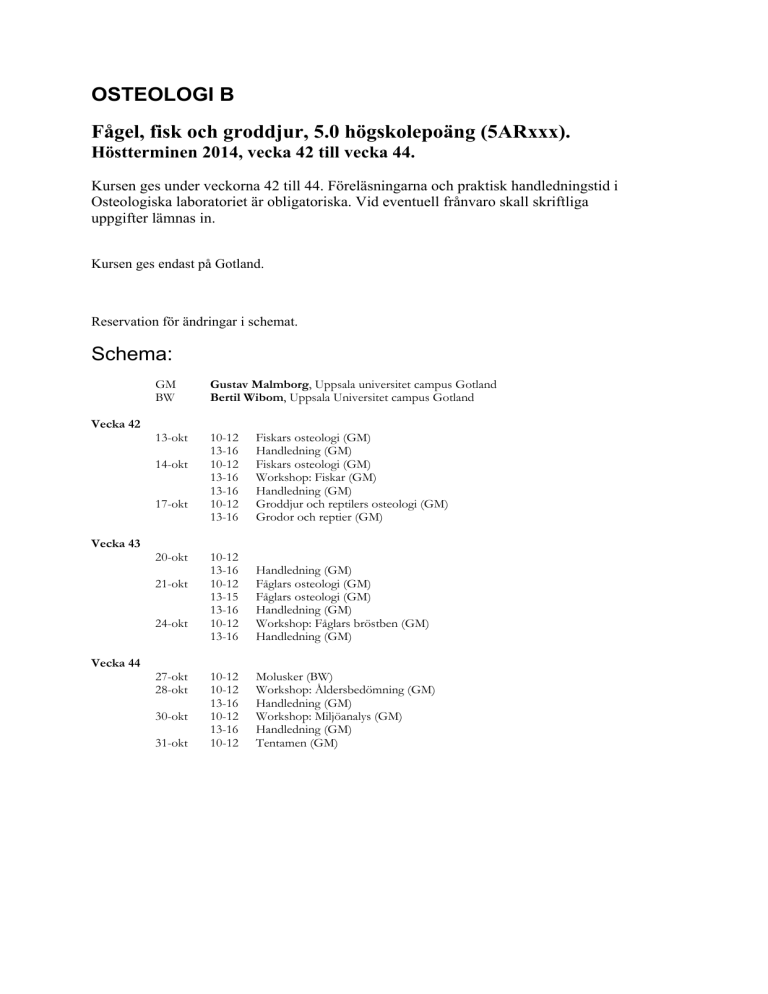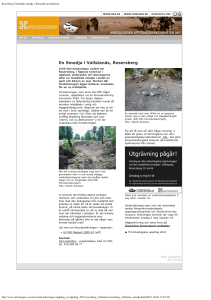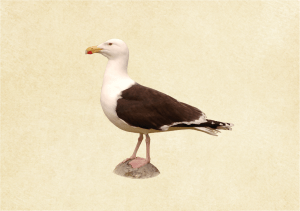
OSTEOLOGI B
Fågel, fisk och groddjur, 5.0 högskolepoäng (5ARxxx).
Höstterminen 2014, vecka 42 till vecka 44.
Kursen ges under veckorna 42 till 44. Föreläsningarna och praktisk handledningstid i
Osteologiska laboratoriet är obligatoriska. Vid eventuell frånvaro skall skriftliga
uppgifter lämnas in.
Kursen ges endast på Gotland.
Reservation för ändringar i schemat.
Schema:
GM
BW
Gustav Malmborg, Uppsala universitet campus Gotland
Bertil Wibom, Uppsala Universitet campus Gotland
13-okt
10-12
13-16
10-12
13-16
13-16
10-12
13-16
Fiskars osteologi (GM)
Handledning (GM)
Fiskars osteologi (GM)
Workshop: Fiskar (GM)
Handledning (GM)
Groddjur och reptilers osteologi (GM)
Grodor och reptier (GM)
10-12
13-16
10-12
13-15
13-16
10-12
13-16
Handledning (GM)
Fåglars osteologi (GM)
Fåglars osteologi (GM)
Handledning (GM)
Workshop: Fåglars bröstben (GM)
Handledning (GM)
10-12
10-12
13-16
10-12
13-16
10-12
Molusker (BW)
Workshop: Åldersbedömning (GM)
Handledning (GM)
Workshop: Miljöanalys (GM)
Handledning (GM)
Tentamen (GM)
Vecka 42
14-okt
17-okt
Vecka 43
20-okt
21-okt
24-okt
Vecka 44
27-okt
28-okt
30-okt
31-okt
Litteratur:
Cohen, A. & Serjeantson, D. 1986. A manual for identification of bird bones from archaeological sites. London
Cannon, D. Y. 1987 Marine Fish osteology – a manual for Archaeologists. Burnaby
Johansson, B. M. 2005. Mollusker, miljö och människa – ett biologiskt synsätt i Sverige. Sammanfattning på
svenska. Chapter 7. I: Molluscs, Environment and Man – A Bioarchaeological Approach in Sweden. Theses
and papers in archaeology. Stockholms universitet, institutionen för arkeologisk och antikvarisk kultur. (Sid. 6465).
Johansson, B. M. 2005. Mollusc Shells in Swedish Archaeology – Occurence, Significance and Potential
(Paper VI). I: Molluscs, Environment and Man – A Bioarchaeological Approach in Sweden. Theses and papers
in archaeology. Stockholms universitet, institutionen för arkeologisk och antikvarisk kultur. (Sid. 89-130).
Enghoff, I. B, MacKenzie, B. R. & Nielsen, E. E. The Danish fish fauna during the warm Atlantic period (ca.
7000–3900 bc): Forerunner of future changes? Fisheries Research 87 (2007). (Sid. 167–180).
*Mannermaa, K, Lougas, L. 2005. Birds and subsistence and cultures on four major Baltic Islands in the
Neolithic (Gotland, Åland, Hiiumaa and Saaremaa). I: Feathers, Grit and Symbolism. Birds and Humans in
the Ancient Old and New Worlds. (Grupe, G & Peters, J. eds.). Documenta Archaeobiologiae 3. (Sid. 179-198).
*Mannermaa, K. och Storå, J. 2006. Stone Age Exploitation of Birds on
the Island of Gotland, Baltic Sea: A Taphonomic Study of the Avifauna
on the Neolithic Site of Ajvide. International Journal of Osteoarchaeology 16. (Sid. 429–452). Published
online in Wiley InterScience (www.interscience.wiley.com) DOI: 10.1002/
Morales, A. & Rosenlund, K. 1979. Fishbone measurements. Zoologisk museum. Köpenhamn.
Nickel, R., Schummer, A. & Seiferle, E. 1992. Anatomie der Vögel. Band. V. Paul Parey, Berlin.
Olson, C., Limburg, K. & Söderblom M. 2008. Stone Age fishhooks – how were they dimensioned?
Morphology, strength test, and breakage pattern of Neolithic bone fishhooks from Ajvide, Gotland,
Sweden. Journal of Archaeological Science. (Sid 2813-2823).
Serjeantson, D. 2009. Birds. Cambridge University Press. (Sid. 15-55, 63-98).
*Maanemaas artiklar finns även i Maanemaas avhandling 2005. Paper III (2006) och IV.

















